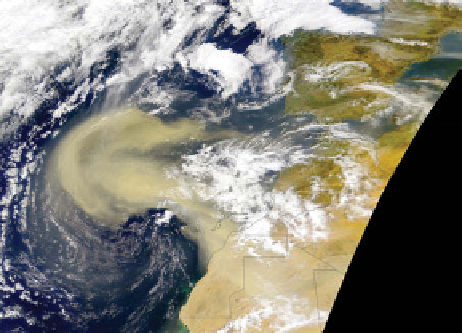Geoscience Reference
In-Depth Information
potassium feldspar
[KAlSi
3
O
8
(s)] and
plagioclase
feldspar
[NaAlSi
3
O
3
-CaAl
2
Si
2
O
8
(s)].
Hematite
[Fe
2
O
3
(s)] (Greek for “bloodlike stone”) is
an oxide mineral because it includes a metallic element
bonded with oxygen. The iron within it causes it to
appear reddish-brown (Figure 1.4).
Calcite
[CaCO
3
(s)] and
dolomite
[CaMg(CO
3
)
2
(s)]
are carbonate minerals. The name calcite is derived
from the word
calcspar
,which was derived from the
Greek word for limestone,
khalix
.Dolomite is similar
in form to calcite. It was named after French geologist
and mineralogist Silvain de Dolomieu (1750-1801).
Gypsum
[CaSO
4
-2H
2
O(s)] and
epsomite
[MgSO
4
-
7H
2
O(s)] are two of only a handful of sulfate-contain-
ing minerals. Gypsum, which ranges from colorless
to white, was named after the Greek word
gypsos
(“plaster”). Epsomite was named after the location -
Epsom, England - where it was first found. As seen in
Table 2.2, sulfur is not an abundant component of the
Earth's crust.
Kaolinite, illite, smectite, vermiculite, and chlo-
rite are all
clays
,which are odorous minerals result-
ing from the weathering of rocks. Clays are usually
soft, compact, and composed of aggregates of small
crystals. The major components of clays are oxygen,
silicon, aluminum, iron, and magnesium.
Kaolinite
[Al
4
Si
4
O
10
(OH)
8
(s) in pure form] was named after the
Chinese word
kauling
(“high ridge”), which is the name
of a hill near Jauchu Fa, where clay for the manufac-
ture of porcelain was dug. Early porcelain clay was
called kaolinite.
Illite
is a mineral group name, orig-
inating from the state name for Illinois, where many
illite minerals were first studied.
Smectite
is a mineral
group name, originating from
smectis
,aGreek name
for “fuller's earth.”
Vermiculite
is a mineral group
name that originates from the Latin word
vermiculari
(“to breed worms”), which refers to the mineral's abil-
ity to exude wormlike structures when rapidly heated.
Chlorite
is a mineral group name, originating from the
Greek word for green, which is the common color of
this group of clays. In addition to containing miner-
als, soils contain organic matter, such as plant litter or
animal tissue broken down by bacteria.
Soil dust
,which consists of the minerals and organic
material making up soil, is lifted into the air by winds.
The extent of lifting depends on the wind speed and
particle mass. Most mass of soil dust lifted into the air
is in particles larger than 1
Table 5.4.
Time for particles to fall 1 km
in the atmosphere by sedimentation
under near-surface conditions
Particle
Time to
diameter (
m)
fall 1 km
0.02
228 years
0.10
36 years
1
328 days
10
3.6 days
100
1.1 hours
1,000
4 minutes
5,000
1.8 minutes
weeks or longer, depending on the height to which they
are originally lifted. Table 5.4 shows the time required
for particles of different diameters to fall 1 km in the
air by sedimentation. The table indicates that particles
1
mindiameter take 328 days to fall 1 km, whereas
those 10
mindiameter take 3.6 days to fall 1 km.
Although most soil dust particles are not initially lofted
more than 1 km in the air, many are, and these particles
can travel long distances before falling to the ground.
Source regions of soil dust on a global scale include
deserts (e.g., the Sahara in North Africa; Gobi in Mon-
golia; Great Basin, Mojave, and Sonora in the south-
western United States; the deserts of Australia) and
regions where foliage has been cleared by biomass burn-
ing and plowing. Figure 5.3 shows a satellite image of
Figure 5.3.
Dust storms originating from northwest
Africa and Portugal/Spain, captured by SeaWiFS
satellite, February 28, 2000. Courtesy SeaWiFS
Project, NASA/Goddard Space Flight Center and
GeoEye, Inc.
mindiameter; thus, soil
dust particles are predominantly coarse mode particles.
Those larger than 10
mfallout quite rapidly, but those
between 1 and 10
m can stay in the air for days to





Search WWH ::

Custom Search